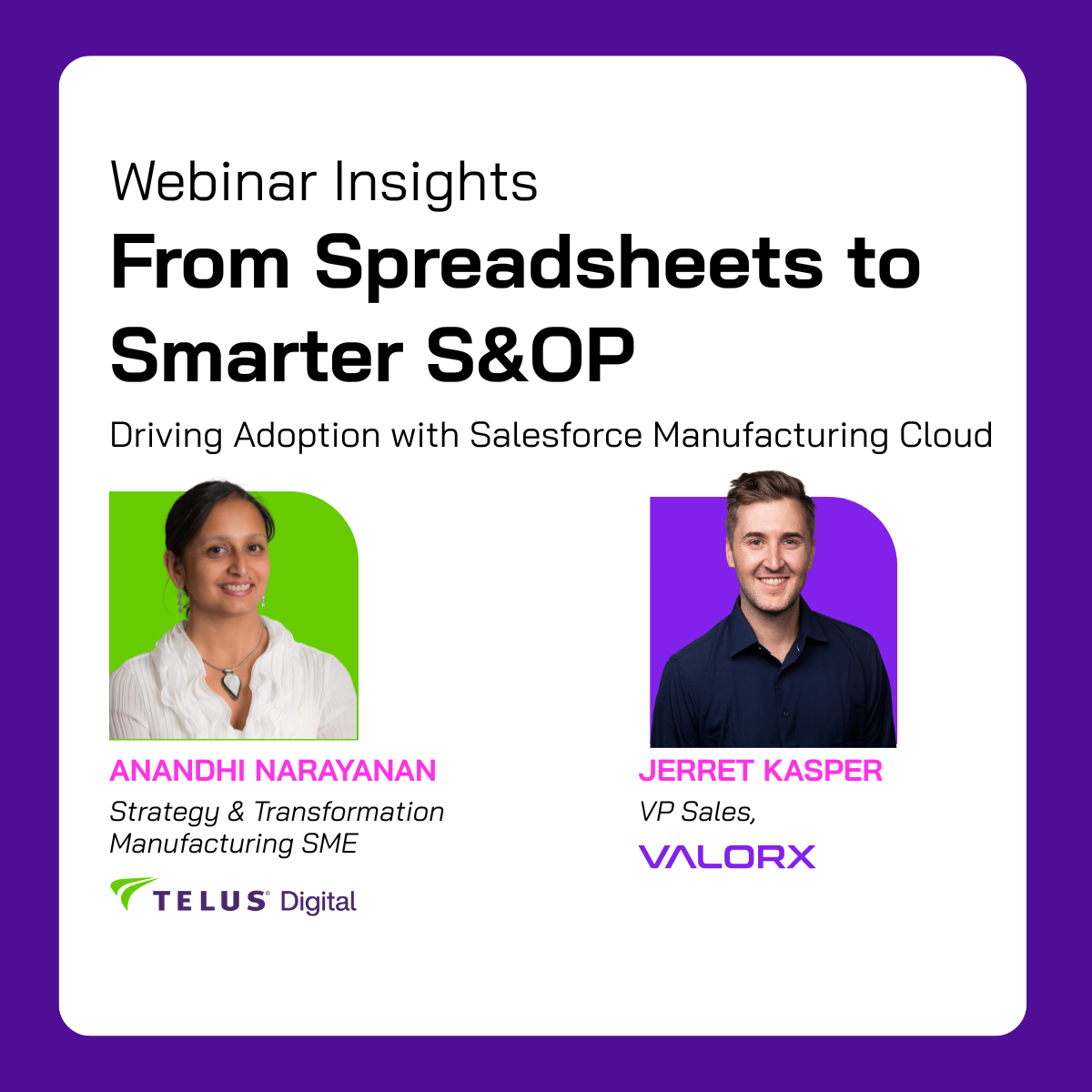Webinar highlights: Leveraging smarter S&OP to maximize Salesforce adoption and ROI

"Salesforce is powerful, but adoption often stalls when users revert to tools they know — spreadsheets. To drive real impact, we need to make complex processes simple and intuitive for every user."
Jerret Kasper, VP of Sales, Valorx
Stat alert: A Salesforce report revealed that only 37% of teams fully embrace their CRM. In other words, when you nail the Salesforce adoption process, you’re not just maximizing your investment — you’re unlocking the full potential of Salesforce to drive sales, streamline workflows, and enhance customer interactions.
Yet for many manufacturers, especially those managing complex S&OP processes, adoption remains elusive. Why? Because users still default to spreadsheets. In this webinar recap, Anandhi Narayanan, Strategy and Transformation Manufacturing SME at TELUS Digital, and Jerret Kasper, VP of Sales at Valorx, break down how global manufacturers are overcoming this challenge — and what practical strategies are working.
Where is the S&OP adoption gap? Why is Salesforce alone not enough?
Manufacturers are under pressure to align sales, operations, and finance. Many invest heavily in Salesforce Manufacturing Cloud expecting a seamless, digital S&OP process. But adoption often stalls.
"The challenge is you invest in Salesforce… but you still see users drifting back to Excel because speed and flexibility beat system usability."
Jerret Kasper, VP of Sales, Valorx
"If you don’t connect the sales process to operations in a digital way, then you again pivot to spreadsheets as your way of gathering the inputs from the various players to support your S&OP process."
Anandhi Narayanan, Strategy and Transformation Manufacturing SME, TELUS Digital
The culprit? Spreadsheets feel faster, more flexible, and easier to model in real-time. That familiarity wins, even when it creates version control issues, data fragmentation, and swivel-chair workflows.
How do you fix this? Bring spreadsheet speed inside Salesforce
Anandhi and Jerret shared how they help leading manufacturers drive Salesforce adoption—not by replacing Excel, but by replicating its speed, flexibility, and interface within the platform.
"Adoption starts with using the platform for what it's best at — and then making the experience intuitive. If users can see all their data in one place and update it quickly, they’ll actually use it. Valorx brings spreadsheet speed into Salesforce — drag, drop, calculate, update — all in real time.
Jerret Kasper, VP of Sales, Valorx
Anandhi added a sharp perspective:
"We all know how fast demand is moving. This isn’t just about digitization—it’s about empowering decision-makers across the value chain with real-time insight."
Anandhi Narayanan, Strategy and Transformation Manufacturing SME, TELUS Digital
Case Study: Qualcomm saved 17,000+ hours and transformed forecasting
Despite having tens of thousands of Salesforce licenses, Qualcomm faced a familiar challenge: poor adoption for the design pipeline and chipset forecasting. Users defaulted to offline spreadsheets, leading to fragmented data, manual effort, and slow updates.

Jerret explained:
“Instead of clicking one by one, they’re able to pull in hundreds of records into a very familiar interface. Change management was very minimal. There is no ‘Jerret, send me the latest spreadsheet’ - you may come into an interface like this that’s different than my seller, but I’m looking at the latest and greatest data as well.”
Jerret Kasper, VP of Sales, Valorx
Personas matter: Tailoring UX by role
Both Anandhi and Jerret emphasized that sellers, planners, and finance teams view the same data differently. The platform must reflect that. Valorx enables:
- Sellers to work from their book of business or territory-level views
- Operations to aggregate and manipulate forecasts by SKU, region, or variant
- Finance to roll up outlooks, analyze risk, and align investor reporting
Top 5 lessons to drive S&OP Salesforce adoption
1️⃣ Don’t fight Excel—replicate it. Give users an interface that feels like what they already trust.
2️⃣ Tailor to personas. Sellers, ops, and finance need different views and functions.
3️⃣ Simplify first, then scale. Start with quick wins to build momentum.
4️⃣ Embed in business rhythm. Integrate with reviews, planning cycles, and forecast cadences.
5️⃣ Unify sales, operations, and finance signals. A true S&OP platform connects all inputs.
Final thought: S&OP is a strategic lever, not just a workflow
Anandhi closed with a powerful point:
"This isn’t just about digitization. It’s about aligning planning to market shifts. That’s the difference between reacting and leading."
Anandhi Narayanan, Strategy and Transformation Manufacturing SME, TELUS Digital
Want to bring spreadsheet speed to your Salesforce S&OP? We’re hosting personalized Lunch & Learn sessions to explore your use case. Whether you’re stuck in spreadsheets or struggling with Salesforce adoption, we’ll show you what’s possible.

